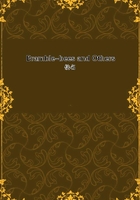
第41章 PERMUTATIONS OF SEX.(8)
Towards the end of the Bee's operations, in the first week of June, the last acts of the Three-horned Osmia become so exceptionally interesting that I made her the object of redoubled observation. The swarm at this time is greatly reduced in numbers. I have still some thirty laggards, who continue very busy, though their work is in vain. I see some very conscientiously stopping up the entrance to a tube or a Snail-shell in which they have laid nothing at all. Others are closing the home after only building a few partitions, or even mere attempts at partitions. Some are placing at the back of a new gallery a pinch of pollen which will benefit nobody and then shutting up the house with an earthen stopper as thick, as carefully made as though the safety of a family depended on it. Born a worker, the Osmia must die working. When her ovaries are exhausted, she spends the remainder of her strength on useless works: partitions, plugs, pollen-heaps, all destined to be left unemployed. The little animal machine cannot bring itself to be inactive even when there is nothing more to be done. It goes on working so that its last vibrations of energy may be used up in fruitless labour. I commend these aberrations to the staunch supporters of reasoning-powers in the animal.
Before coming to these useless tasks, my laggards have laid their last eggs, of which I know the exact cells, the exact dates. These eggs, as far as the microscopes can tell, differ in no respect from the others, the older ones. They have the same dimensions, the same shape, the same glossiness, the same look of freshness. Nor are their provisions in any way peculiar, being very well suited to the males, who conclude the laying. And yet these last eggs do not hatch: they wrinkle, fade and wither on the pile of food. In one case, I count three or four sterile eggs among the last lot laid; in another, Ifind two or only one. Elsewhere in the swarm, fertile eggs have been laid right up to the end.
Those sterile eggs, stricken with death at the moment of their birth, are too numerous to be ignored. Why do they not hatch like the other eggs, which outwardly they resemble in every respect? They have received the same attention from the mother and the same portion of food. The searching microscope shows me nothing in them to explain the fatal ending.
To the unprejudiced mind, the answer is obvious. Those eggs do not hatch because they have not been fertilized. Any animal or vegetable egg that had not received the life-giving impregnation would perish in the same way. No other answer is possible. It is no use talking of the distant period of the laying: eggs of the same period laid by other mothers, eggs of the same date and likewise the final ones of a laying, are perfectly fertile. Once more, they do not hatch because they were not fertilized.
And why were they not fertilized? Because the seminal receptacle, so tiny, so difficult to see that it sometimes escaped me despite all my scrutiny, had exhausted its contents. The mothers in whom this receptacle retained a remnant of sperm to the end had their last eggs as fertile as the first; the others, whose seminal reservoir was exhausted too soon, had their last-born stricken with death. All this seems to me as clear as daylight.
If the unfertilized eggs perish without hatching, those which hatch and produce males are therefore fertilized; and the German theory falls to the ground.
Then what explanation shall I give of the wonderful facts which Ihave set forth? Why, none, absolutely none. I do not explain facts, Irelate them. Growing daily more sceptical of the interpretations suggested to me and more hesitating as to those which I may have to suggest myself, the more I observe and experiment, the more clearly Isee rising out of the black mists of possibility an enormous note of interrogation.
Dear insects, my study of you has sustained me and continues to sustain me in my heaviest trials. I must take leave of you for to-day. The ranks are thinning around me and the long hopes have fled. Shall I be able to speak to you again? (This is the closing paragraph of Volume 3 of the "Souvenirs entomologiques," of which the author has lived to publish seven more volumes, containing over 2,500pages and nearly 850,000 words.--Translator's Note.)